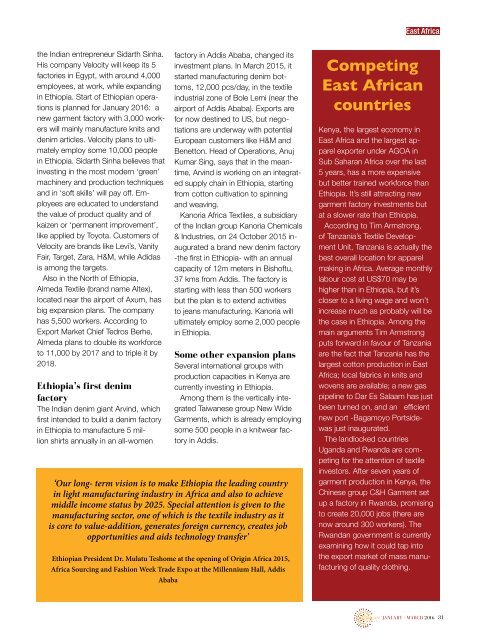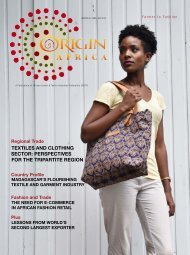You also want an ePaper? Increase the reach of your titles
YUMPU automatically turns print PDFs into web optimized ePapers that Google loves.
East <strong>Africa</strong><br />
the Indian entrepreneur Sidarth Sinha.<br />
His company Velocity will keep its 5<br />
factories in Egypt, with around 4,000<br />
employees, at work, while expanding<br />
in Ethiopia. Start of Ethiopian operations<br />
is planned for January 2016: a<br />
new garment factory with 3,000 workers<br />
will mainly manufacture knits and<br />
denim articles. Velocity plans to ultimately<br />
employ some 10,000 people<br />
in Ethiopia. Sidarth Sinha believes that<br />
investing in the most modern ‘green’<br />
machinery and production techniques<br />
and in ‘soft skills’ will pay off. Employees<br />
are educated to understand<br />
the value of product quality and of<br />
kaizen or ‘permanent improvement’,<br />
like applied by Toyota. Customers of<br />
Velocity are brands like Levi’s, Vanity<br />
Fair, Target, Zara, H&M, while Adidas<br />
is among the targets.<br />
Also in the North of Ethiopia,<br />
Almeda Textile (brand name Altex),<br />
located near the airport of Axum, has<br />
big expansion plans. The company<br />
has 5,500 workers. According to<br />
Export Market Chief Tedros Berhe,<br />
Almeda plans to double its workforce<br />
to 11,000 by 2017 and to triple it by<br />
2018.<br />
Ethiopia’s first denim<br />
factory<br />
The Indian denim giant Arvind, which<br />
first intended to build a denim factory<br />
in Ethiopia to manufacture 5 million<br />
shirts annually in an all-women<br />
factory in Addis Ababa, changed its<br />
investment plans. In March 2015, it<br />
started manufacturing denim bottoms,<br />
12,000 pcs/day, in the textile<br />
industrial zone of Bole Lemi (near the<br />
airport of Addis Ababa). Exports are<br />
for now destined to US, but negotiations<br />
are underway with potential<br />
European customers like H&M and<br />
Benetton. Head of Operations, Anuj<br />
Kumar Sing, says that in the meantime,<br />
Arvind is working on an integrated<br />
supply chain in Ethiopia, starting<br />
from cotton cultivation to spinning<br />
and weaving.<br />
Kanoria <strong>Africa</strong> Textiles, a subsidiary<br />
of the Indian group Kanoria Chemicals<br />
& Industries, on 24 October 2015 inaugurated<br />
a brand new denim factory<br />
-the first in Ethiopia- with an annual<br />
capacity of 12m meters in Bishoftu,<br />
37 kms from Addis. The factory is<br />
starting with less than 500 workers<br />
but the plan is to extend activities<br />
to jeans manufacturing. Kanoria will<br />
ultimately employ some 2,000 people<br />
in Ethiopia.<br />
Some other expansion plans<br />
Several international groups with<br />
production capacities in Kenya are<br />
currently investing in Ethiopia.<br />
Among them is the vertically integrated<br />
Taiwanese group New Wide<br />
Garments, which is already employing<br />
some 500 people in a knitwear factory<br />
in Addis.<br />
‘Our long- term vision is to make Ethiopia the leading country<br />
in light manufacturing industry in <strong>Africa</strong> and also to achieve<br />
middle income status by 2025. Special attention is given to the<br />
manufacturing sector, one of which is the textile industry as it<br />
is core to value-addition, generates foreign currency, creates job<br />
opportunities and aids technology transfer’<br />
Ethiopian President Dr. Mulatu Teshome at the opening of <strong>Origin</strong> <strong>Africa</strong> 2015,<br />
<strong>Africa</strong> Sourcing and Fashion Week Trade Expo at the Millennium Hall, Addis<br />
Ababa<br />
Competing<br />
East <strong>Africa</strong>n<br />
countries<br />
Kenya, the largest economy in<br />
East <strong>Africa</strong> and the largest apparel<br />
exporter under AGOA in<br />
Sub Saharan <strong>Africa</strong> over the last<br />
5 years, has a more expensive<br />
but better trained workforce than<br />
Ethiopia. It’s still attracting new<br />
garment factory investments but<br />
at a slower rate than Ethiopia.<br />
According to Tim Armstrong,<br />
of Tanzania’s Textile Development<br />
Unit, Tanzania is actually the<br />
best overall location for apparel<br />
making in <strong>Africa</strong>. Average monthly<br />
labour cost at US$70 may be<br />
higher than in Ethiopia, but it’s<br />
closer to a living wage and won’t<br />
increase much as probably will be<br />
the case in Ethiopia. Among the<br />
main arguments Tim Armstrong<br />
puts forward in favour of Tanzania<br />
are the fact that Tanzania has the<br />
largest cotton production in East<br />
<strong>Africa</strong>; local fabrics in knits and<br />
wovens are available; a new gas<br />
pipeline to Dar Es Salaam has just<br />
been turned on, and an efficient<br />
new port -Bagamoyo Portsidewas<br />
just inaugurated.<br />
The landlocked countries<br />
Uganda and Rwanda are competing<br />
for the attention of textile<br />
investors. After seven years of<br />
garment production in Kenya, the<br />
Chinese group C&H Garment set<br />
up a factory in Rwanda, promising<br />
to create 20,000 jobs (there are<br />
now around 300 workers). The<br />
Rwandan government is currently<br />
examining how it could tap into<br />
the export market of mass manufacturing<br />
of quality clothing.<br />
JANUARY - MARCH 2016 31



